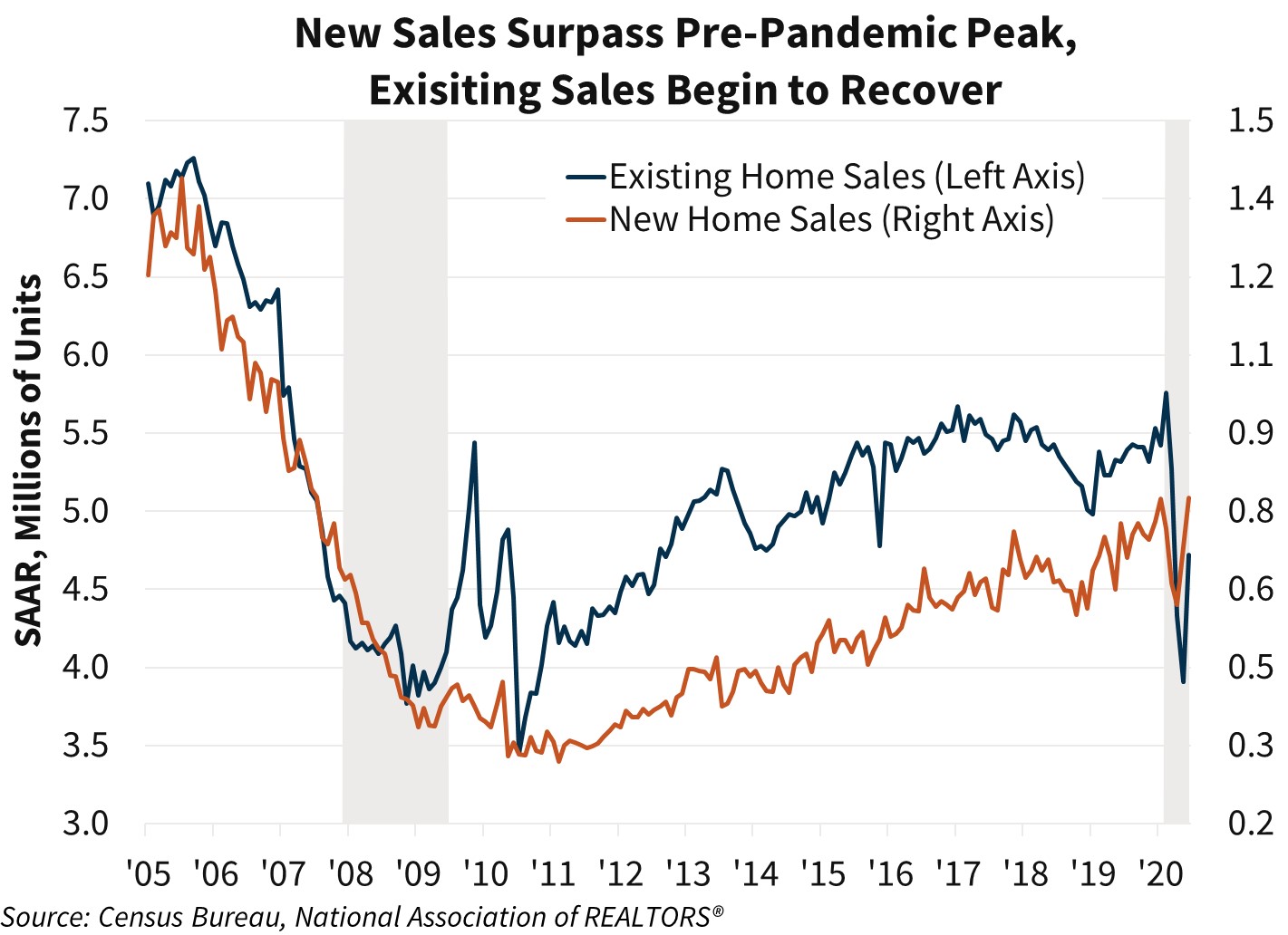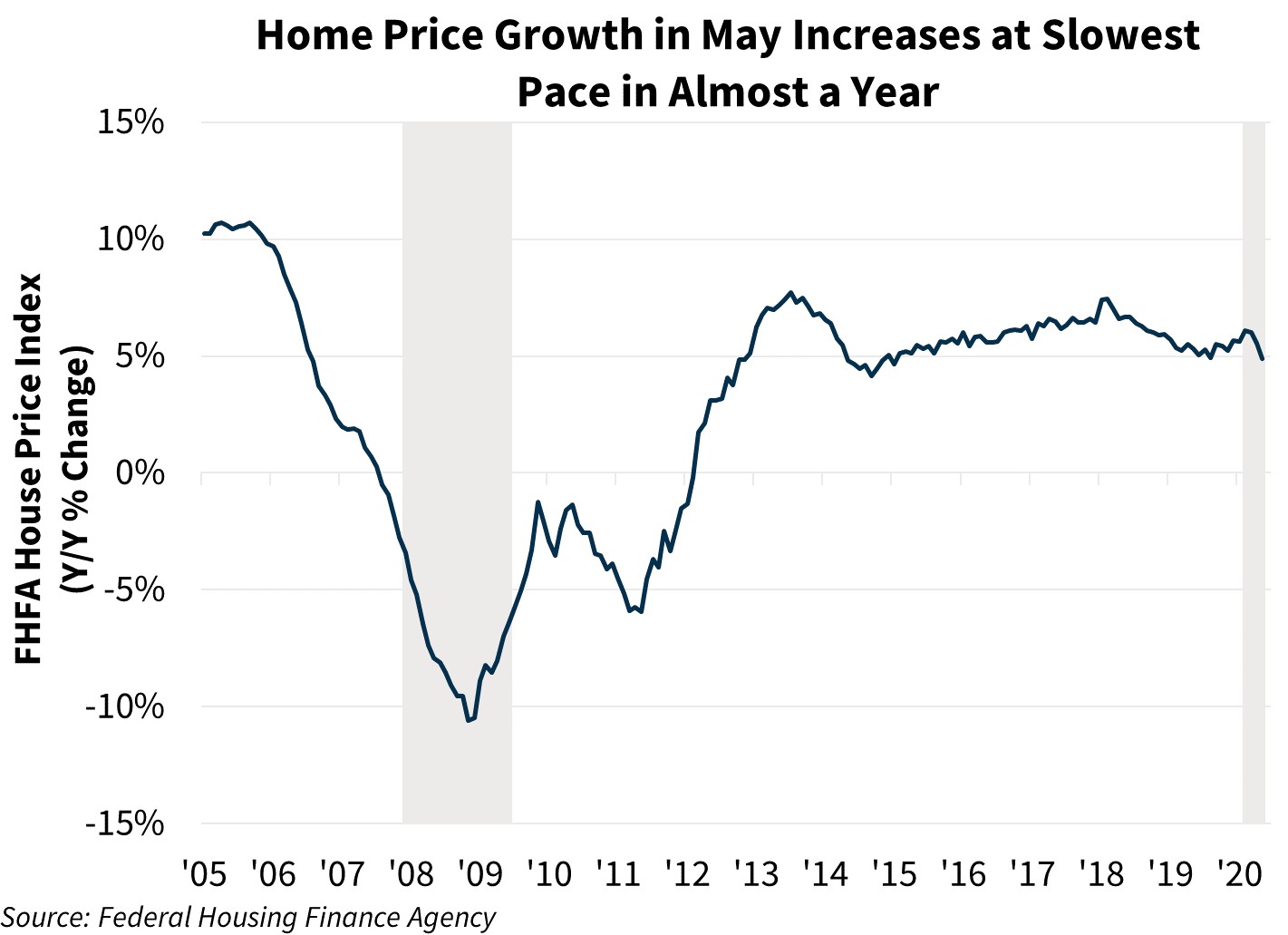Housing Paints a Picture of Resiliency, For Now
Key Takeaways:
- The Conference Board Leading Economic Index (LEI), a gauge of the economic outlook over the next three to six months, increased 2.0 percent in June to 102. According to the press release, the increase in the LEI “reflects improvements brought about by the incremental reopening of the economy, with labor market conditions and stock prices in particular contributing positively,” though the press release also cautions that “broader financial conditions and the consumers’ outlook on business conditions still point to a weak economic outlook.”
- Existing home sales jumped 20.7 percent in June to a seasonally adjusted annualized rate (SAAR) of 4.72 million, the largest increase in series history, according to the National Association of REALTORS®. Single-family sales increased 19.9 percent to a SAAR of 4.28 million, while condo/co-op sales rose 29.4 percent to a SAAR of 440,000. Total existing homes available for sale fell 18.2 percent from a year ago, the thirteenth consecutive month of annual decline. The months’ supply fell eight-tenths to 4.0, the largest decline since December 2015 and the lowest June reading ever. On a quarterly basis, total existing sales fell 21.2 percent in the second quarter to a SAAR quarterly average 4.32 million, the largest decline since Q3 2010.
- New single-family home sales jumped 13.8 percent in June to a SAAR of 776,000, according to the Census Bureau, surpassing the peak in January and reaching the highest level in almost 13 years. Sales rose in every region, with the largest increase being in the Northeast, where sales rose 89.7 percent from May. Sales of homes not yet started jumped 56.4 percent to a SAAR of 233,000, the second largest increase in series history. The inventory of new homes for sale fell to the lowest level in two years, while the months’ supply fell eight-tenths to 4.7, the lowest reading in almost four years. From a year ago, the median sale price rose 5.6 percent, likely partially due to the compositional shift of sales given the large increase of sales in the Northeast. On a quarterly basis, sales fell 3.5 percent to a SAAR of 676,000, the lowest Q2 reading in a year.
- The FHFA Purchase-Only House Price Index, reported on a seasonally adjusted basis, fell 0.3 percent in May, the first month of decline since January 2017. From a year ago, the index rose 4.9 percent, the slowest annual pace of growth since August 2019.
- Mortgage applications rose 4.1 percent for the week ending July, according to the Mortgage Bankers Association. Purchase applications rose by 1.8 percent, while refinance applications increased 5.3 percent. From a year ago, purchase applications rose 19.4 percent and refinance applications rose 122.0 percent.
Forecast Impact
Housing activity in June continues to highlight the industry’s relative resilience thus far to the economic uncertainty that many other industries are experiencing in the wake of the coronavirus. While both existing and new home sales rose sharply in June, existing sales remain well below their recent peak in February. New home sales, however, rose past their pre-pandemic peak, driven by a surge in sales of homes which have not yet been started. We believe the pace of increase in June, along with the increase in purchase applications in July, suggests more strength in sales in the coming months. However, the lack of inventories and the rise in sales prices will likely limit the amount that sales can rise. Another downside risk to the outlook for home sales is the current resurgence in coronavirus cases. Sales in the South and West accounted for 82 percent of new home sales and 66 percent of existing home sales in June. However, these are the regions most impacted by the recent increase in cases, and so a significant pullback in activity in these regions due to the virus could seriously dampen sales in the coming months. The Conference Board LEI also underscores the potential downside risks to housing, stating that while labor market conditions have improved given the reopening of the economy, the business outlook of consumers and financial conditions point to a weak outlook going forward, which could be exacerbated by the increase in cases across the country.


Economic and Strategic Research Group
July 24, 2020
Opinions, analyses, estimates, forecasts and other views of Fannie Mae's Economic and Strategic Research (ESR) Group included in these materials should not be construed as indicating Fannie Mae's business prospects or expected results, are based on a number of assumptions, and are subject to change without notice. How this information affects Fannie Mae will depend on many factors. Although the ESR group bases its opinions, analyses, estimates, forecasts and other views on information it considers reliable, it does not guarantee that the information provided in these materials is accurate, current or suitable for any particular purpose. Changes in the assumptions or the information underlying these views, including assumptions about the duration and magnitude of shutdowns and social distancing, could produce materially different results. The analyses, opinions, estimates, forecasts and other views published by the ESR group represent the views of that group as of the date indicated and do not necessarily represent the views of Fannie Mae or its management.
